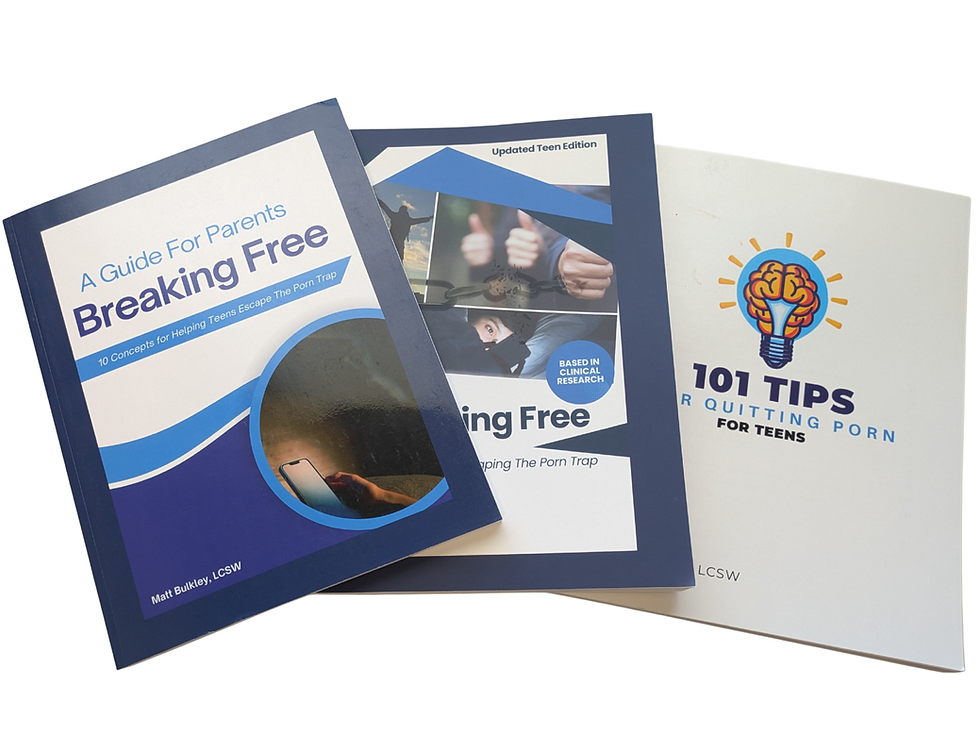Helping Your Teen Overcome Pornography Addiction: The Importance of Limiting Solo Screen Time
- Matt Bulkley

- Jun 25
- 4 min read
As a parent, supporting your teen through the challenge of pornography addiction can feel daunting. One practical, research-backed strategy to help them stay on track is to limit their alone time with screens. Excessive solo screen time can open the door to relapse, but by creating boundaries around device use, you can help your teen build a healthier lifestyle and reduce the pull of harmful habits. Here’s why this approach is effective and how you can guide your teen toward success.
Why Solo Screen Time Is a Risk
Pornography addiction often thrives in moments of solitude, particularly when teens are alone with their devices. Research from Addictive Behaviors highlights that isolated screen time is a prime trigger for cravings in behavioral addictions. The brain’s reward system, which pornography hijacks, is more vulnerable when teens are alone with unrestricted access to phones, tablets, or computers. These moments of idle scrolling can quickly lead to old habits resurfacing, as there’s no external accountability to keep them in check.
Studies show that reducing solitary screen time can significantly lower the risk of relapse. By cutting back on these “me, myself, and my device” moments, your teen is less likely to encounter triggers that fuel addiction. Instead, they can focus on real-world connections and activities that promote well-being.
What the Experts Say
Therapists who specialize in addiction recovery emphasize the power of limiting solo screen time. They often use a strategy called “environmental control” in cognitive-behavioral therapy (CBT), which involves restructuring a person’s surroundings to minimize temptation. For many teens, screens are the gateway to pornography, and being alone with a device removes any natural accountability. Clinicians have observed that teens who set clear boundaries—such as avoiding screens in private spaces like bedrooms or turning off devices during downtime—are more successful at maintaining their recovery goals.
Experts also point out that idle time is a major risk factor. Research indicates that up to 60% of relapses occur when individuals are alone with nothing to do. By encouraging your teen to engage in activities with others or in shared spaces, you help them avoid the isolation that often leads to slip-ups. This shift not only disrupts the cycle of addiction but also fosters healthier habits.
The Benefits of Structured and Social Screen Use
Limiting solo screen time doesn’t mean banning technology altogether. Instead, it’s about creating intentional boundaries. Studies suggest that teens who use screens in social or structured settings—such as watching a movie with family or gaming with friends—are less likely to fall back into addictive patterns. These activities keep technology use purposeful and connected, reducing the temptation to seek out harmful content.
For example, a teen who commits to only using their phone in the living room or during group activities is less likely to encounter triggers than one scrolling alone late at night. This approach also encourages accountability, as the presence of others naturally discourages risky behavior.
How Parents Can Help
Here are actionable steps to help your teen limit solo screen time and support their recovery:
Open a Dialogue: Talk to your teen about the risks of excessive solo screen time in a non-judgmental way. Frame it as a positive step toward their goals, focusing on how it can help them feel more connected and in control.
Set Clear Boundaries: Work together to create rules, such as “no screens in the bedroom” or “devices stay off when alone.” Encourage them to keep phones in shared spaces, like the kitchen or living room.
Encourage Social Activities: Help your teen find opportunities to spend time with friends or family, whether through sports, hobbies, or group outings. These activities fill downtime and reduce the urge to isolate with a screen.
Model Healthy Habits: Show your teen how to use technology mindfully by setting your own boundaries. For example, designate screen-free times for the whole family, like during meals or before bed.
Provide Alternatives: Suggest engaging activities to replace solo screen time, such as reading, journaling, or creative projects. Even simple routines like family game nights can make a big difference.
Use Parental Controls: Consider tools that limit access to certain apps or websites during specific times. These can provide an extra layer of support while your teen builds new habits.
A Step Toward Recovery
Limiting solo screen time is a powerful, evidence-based strategy to help your teen stay free from pornography addiction. By reducing opportunities for temptation and encouraging real-world connections, you’re empowering them to take control of their choices and build a healthier future. This approach isn’t about cutting out technology—it’s about using it wisely and fostering an environment where your teen can thrive.
For additional support, consider consulting a therapist who specializes in adolescent addiction or exploring community programs that promote healthy activities slung. Together, you can help your teen navigate their recovery with confidence and purpose.
Take Action Today: Sit down with your teen to create a plan for managing screen time, and explore fun, social alternatives to keep them engaged. Small changes can lead to big victories in their journey to recovery.










Comments